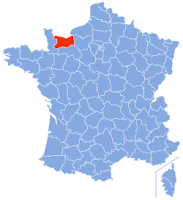If you have a dinner party planned, scratch the menu. No social meal on your calendar? Get one, stat.
Today’s menu will blow anyone away.
Instruction #19
- Green asparagus and crab charlotte, citrus vinaigrette
- Roast beef tenderloin, mi-venaison, marinade with soy, daikon radish and beet brochette, parsley potato crisp
- Frothy caramel with sea salt from Guérande
Thicken fresh crab meat with mayonnaise. Fill an asparagus lined mold. And keep refrigerated until serving.
Meanwhile. Blend peeled, seeded, and diced tomatoes with olive oil, tomato paste (for color), salt, pepper, and sugar (for the acidity) until smooth. Attention not to over blend, retaining a deep red color.
Mix orange, lemon, and lime juice with zest, salt, and pepper. Slowly whisk in olive oil. Creating a citrus vinaigrette.

Flavor and presentation will easily wow your guests. This entire dish can be made in advance, allowing you to enjoy it as well.
Likewise. The main course can be made ahead of time. For at least an hour, preferably overnight, marinate beef tenderloin. Shallot, celery, garlic, thyme, juniper berries, black peppercorns, soy sauce, red wine vinegar, red wine, onion, and orange peel.
Begin a sauce by browning meat trimmings. Sweating carrot, onion, and celery. Deglazing with red wine and balsamic vinegars. Once evaporated dry, deglaze a second time, this round with cognac. Pour enough marinade to cover the solids, add thyme and bay leaf, and reduce two-thirds. Next, add veal stock and greatly reduce. Finish with redcurrant jelly and crushed peppercorns giving them a moment to infuse the sauce. Strain and reduce to desired consistency.
Simply brown the marinated meat in screaming hot oil. And cook through in a 200 degree Celsius oven – 15 minutes per pound for rare/medium-rare.
Garnish with cooked daikon radish and beet. And heavenly parsley potato crisps.
Boiled, diced, buttered, creamed, herb-ed potatoes were wrapped in butter-brushed phyllo dough. Rolled like a spring roll and browned in a 200 degree Celsius oven for about five minutes. Careful when biting into these, they can be hot.

If your guests haven’t hired you to cater their next party by now. Then dessert certainly will.

Caramel – melted sugar deglazed with milk and cream – is
frothed with beaten egg whites. Gelled with gelatin and allowed to set. Think caramel Jell-O. Cognac deglazed caramel syrup adds the finishing touch to the dish.
If you’re not completely satisfied with today’s menu then you can bring it up to demo-Chef Poupard. I’m sure he’d be willing to help you out.







































